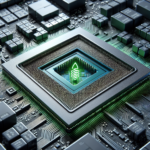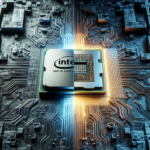Energy Efficiency in Modern CPUs: What You Need to Know

“`markdown
Introduction
In the rapidly evolving world of technology, energy efficiency in modern CPUs has become a critical focus for both manufacturers and consumers. As the demand for more powerful and efficient computing devices grows, understanding how CPUs manage energy consumption is essential. This article delves into the intricacies of energy efficiency in modern CPUs, exploring the technologies, strategies, and innovations that drive this crucial aspect of computing.
The Importance of Energy Efficiency in CPUs
Energy efficiency in CPUs is not just about reducing electricity bills; it has far-reaching implications for performance, sustainability, and the environment. Here are some key reasons why energy efficiency is vital:
- Performance: Efficient CPUs can deliver high performance without generating excessive heat, which can throttle performance and reduce the lifespan of the hardware.
- Battery Life: For mobile devices like laptops, tablets, and smartphones, energy-efficient CPUs extend battery life, providing users with longer usage times between charges.
- Environmental Impact: Lower energy consumption reduces the carbon footprint of computing devices, contributing to environmental sustainability.
- Cost Savings: Energy-efficient CPUs can lead to significant cost savings for both individual users and large data centers by reducing electricity consumption.
Technologies Driving Energy Efficiency in Modern CPUs
Advanced Process Nodes
One of the primary factors contributing to energy efficiency in modern CPUs is the use of advanced process nodes. Semiconductor manufacturers like Intel, AMD, and TSMC are continually pushing the boundaries of silicon fabrication, moving from larger nodes (e.g., 14nm) to smaller ones (e.g., 7nm, 5nm, and even 3nm). Smaller process nodes allow for more transistors to be packed into a given area, reducing power consumption and heat generation while increasing performance.
Dynamic Voltage and Frequency Scaling (DVFS)
Dynamic Voltage and Frequency Scaling (DVFS) is a technique used to adjust the voltage and frequency of a CPU dynamically based on the workload. By lowering the voltage and frequency during less demanding tasks, the CPU can significantly reduce power consumption. Conversely, it can ramp up the voltage and frequency for more intensive tasks, ensuring optimal performance when needed.
Power Gating
Power gating is a technique that involves shutting down parts of the CPU that are not in use. Modern CPUs are designed with multiple cores and various functional units, and not all of them are active at all times. By selectively turning off idle components, power gating helps reduce overall power consumption and heat generation.
Clock Gating
Clock gating is similar to power gating but focuses on disabling the clock signal to inactive parts of the CPU. Since the clock signal drives the operation of transistors, stopping the clock in unused sections can save power without completely shutting down those parts. This technique is particularly useful for reducing dynamic power consumption.
Low-Power States (C-States)
Modern CPUs support various low-power states, known as C-states, which allow them to enter different levels of power-saving modes when idle. These states range from light sleep modes (C1) to deep sleep modes (C6 and beyond), where more components are powered down. The deeper the C-state, the more power is saved, but the longer it takes for the CPU to wake up and resume full operation.
Energy Efficiency in Different CPU Architectures
x86 Architecture
The x86 architecture, used by Intel and AMD, has seen significant advancements in energy efficiency over the years. Both companies have implemented various techniques to optimize power consumption, including the use of advanced process nodes, DVFS, and power gating. Intel’s latest Alder Lake processors and AMD’s Ryzen 5000 series are prime examples of energy-efficient x86 CPUs.
ARM Architecture
ARM architecture, known for its power efficiency, is widely used in mobile devices and increasingly in servers and desktops. ARM CPUs, such as those found in Apple’s M1 and M1 Pro chips, leverage a combination of high-efficiency and high-performance cores to balance power consumption and performance. This big.LITTLE architecture allows for efficient handling of diverse workloads.
RISC-V Architecture
RISC-V is an open-source CPU architecture that has gained traction for its flexibility and energy efficiency. By allowing designers to customize the instruction set, RISC-V can be tailored for specific applications, optimizing power consumption. This architecture is particularly promising for embedded systems and IoT devices where energy efficiency is paramount.
Energy Efficiency in Data Centers
Data centers are major consumers of electricity, and improving CPU energy efficiency in these environments is crucial for reducing operational costs and environmental impact. Here are some strategies employed in data centers:
Server Consolidation
By consolidating workloads onto fewer servers with energy-efficient CPUs, data centers can reduce the number of active servers, leading to significant energy savings. Virtualization technologies play a key role in this process, allowing multiple virtual machines to run on a single physical server.
Efficient Cooling Solutions
Efficient cooling solutions, such as liquid cooling and advanced airflow management, help maintain optimal operating temperatures for CPUs, reducing the need for excessive cooling power. Lower temperatures also enhance CPU performance and longevity.
Renewable Energy Integration
Many data centers are integrating renewable energy sources, such as solar and wind power, to offset their electricity consumption. By using energy-efficient CPUs in conjunction with renewable energy, data centers can achieve a more sustainable operation.
Future Trends in CPU Energy Efficiency
Heterogeneous Computing
Heterogeneous computing involves using different types of processors (e.g., CPUs, GPUs, and specialized accelerators) to handle specific tasks more efficiently. By offloading certain workloads to more energy-efficient processors, overall power consumption can be reduced. This approach is becoming increasingly common in modern computing systems.
AI and Machine Learning
Artificial intelligence (AI) and machine learning (ML) are being leveraged to optimize CPU energy efficiency. AI algorithms can predict workload patterns and dynamically adjust power settings to maximize efficiency. Additionally, ML models can identify inefficiencies in CPU operation and suggest improvements.
Quantum Computing
While still in its infancy, quantum computing holds the potential to revolutionize energy efficiency in computing. Quantum computers can perform certain calculations much faster than classical computers, potentially reducing the energy required for complex computations. However, significant advancements are needed before quantum computing becomes mainstream.
FAQ
What is the most energy-efficient CPU architecture?
ARM architecture is generally considered the most energy-efficient, especially for mobile devices. However, x86 and RISC-V architectures have also made significant strides in energy efficiency.
How does dynamic voltage and frequency scaling (DVFS) improve energy efficiency?
DVFS improves energy efficiency by adjusting the CPU’s voltage and frequency based on the workload. Lowering these parameters during less demanding tasks reduces power consumption, while increasing them during intensive tasks ensures optimal performance.
What are C-states in CPUs?
C-states are low-power states that CPUs can enter when idle. These states range from light sleep modes (C1) to deep sleep modes (C6 and beyond), with deeper states saving more power but taking longer to wake up from.
How do data centers improve CPU energy efficiency?
Data centers improve CPU energy efficiency through server consolidation, efficient cooling solutions, and integrating renewable energy sources. These strategies help reduce operational costs and environmental impact.
What role does AI play in CPU energy efficiency?
AI algorithms can optimize CPU energy efficiency by predicting workload patterns and dynamically adjusting power settings. Machine learning models can also identify inefficiencies in CPU operation and suggest improvements.
Conclusion
Energy efficiency in modern CPUs is a multifaceted topic that encompasses advanced technologies, innovative architectures, and strategic implementations. As the demand for powerful yet efficient computing devices continues to grow, understanding the mechanisms behind CPU energy efficiency becomes increasingly important. By leveraging advanced process nodes, dynamic voltage and frequency scaling, power gating, and other techniques, manufacturers are pushing the boundaries of what is possible. The future of energy-efficient computing looks promising, with trends like heterogeneous computing, AI optimization, and quantum computing on the horizon. Ultimately, energy-efficient CPUs benefit not only individual users but also the environment and society as a whole.
“`




